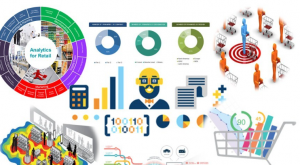Are you a beginner in marketing analytics? Want to improve your ROI and learn more about customer behavior? Take a look at this easy beginner’s guide to marketing analytics, focusing on ecommerce analytics for business growth.

What is Ecommerce Analytics?
At the forefront, ecommerce analytics involves the systematic collection and analysis of data from an online store to empower informed decision-making. This robust practice encompasses tracking key metrics such as
- sales,
- customer behavior, and
- website performance.
By providing valuable insights, ecommerce analytics facilitates the optimization of marketing strategies, improvement of customer experience, and an overall boost in profitability.
While many companies acknowledge the significance of ecommerce data, a staggering 80% of marketing executives find it challenging to make data-driven decisions, despite the abundance of information at their disposal. This guide aims to familiarize you with the language of analytics and assist you in tracking pertinent ecommerce metrics. This understanding will not only shed light on customer actions but also empower you to serve them better, ultimately leading to increased sales.
How Does Ecommerce Analytics Work?
Ecommerce analytics, at its core, serves as the compass for making sense of the complex web of data generated by an online store. It tackles metrics ranging from sales and customer behavior to website performance, providing a holistic view that is indispensable for optimizing marketing strategies, enhancing customer experience, and driving overall profitability.
In the realm of marketing analytics, the focus is on showcasing the return on investment (ROI) for campaigns, facilitating better decision-making to increase sales, reduce costs, and drive business improvements. It also plays a crucial role in centralizing and managing data, addressing the common challenge faced by businesses today – the proliferation of multiple data sources. Siva K. Balasubramanian, associate dean and professor of marketing at Illinois Tech’s Stuart School of Business, emphasizes that analytics offers techniques to organize data effectively. This enables the development of metrics tailored to continuously monitor business performance, with a keen focus on issues critical to the business.
What are the Benefits of Ecommerce Analytics?
Now that the foundation of ecommerce analytics is established, let’s explore the compelling reasons why integrating this approach is indispensable for any ecommerce business:
Understanding Marketing Data: Marketing analytics software consolidates data, enabling comprehensive monitoring of campaigns, from social ads to emails. Real-time statistics aid quick decision-making on marketing budget allocation for maximum impact.
Uncovering Trends: Modern ecommerce analytics sees data as an interconnected system, allowing identification of trends. This approach provides a comprehensive understanding of present and future business performance, helping stay ahead of market trends.
Using Customer Data: Marketing analytics empowers brands to collect, manage, and leverage customer data effectively. Reports on growth, engagement, and revenue offer insights into customer behaviors, facilitating personalized content creation.
Optimizing Pricing: Ecommerce analytics is crucial for understanding how pricing influences purchasing decisions across different customer segments. It helps determine optimal price points to maximize revenue, recognizing pricing as a powerful lever for profitability.
Types of Ecommerce Analytics Metrics
For those embarking on their journey into ecommerce analytics, understanding key metrics is paramount. Here are five fundamental metrics to focus on:
- Customer Lifetime Value (CLV) Measures the profit generated from an average customer during their tenure as a customer.
- Returning Visitors Indicates the percentage of users who return to your site after their initial visit, offering insights into the loyalty of your customer base.
- Time on Site Represents the average time users spend on your site per visit, serving as a crucial indicator of the overall customer experience.
- Pages per Visit Indicates the average number of pages users navigate on your site in a single visit, providing insights into the depth of engagement with your content.
- Bounce Rate Reflects the percentage of users who visit a single page on your website and leave without taking any action, offering insights into the effectiveness of your site’s first impression.

Analytics for Different Business Phases
Understanding that ecommerce businesses undergo distinct phases, each with its challenges and metrics, is essential. Let’s explore two crucial phases:
Customer Acquisition Efficiency
Metrics include conversion rate, page load time, and customer acquisition cost (CAC). Optimization during this phase ensures that your website is user-friendly and quick to load, enhancing the overall user experience.
Scaling Growth
Key metrics involve transactions, average order value (AOV), revenue, and unique visitors. As you scale, keeping a close eye on these metrics ensures steady growth and a positive impact on overall business performance.
Customer Acquisition Channels and Metrics
Navigating popular channels such as SEO, SEM, Facebook ads, and email marketing requires a nuanced understanding of specific metrics. Let’s delve into these channels and their associated metrics:
SEO (Search Engine optimization)
Metrics involve search volume, average ranking position, bounce rate, conversion rate, and revenue from organic traffic.
SEM (Search Engine Marketing)
Metrics include search volume, cost per click (CPC), average ranking position, click-through rate (CTR), bounce rate, conversion rate, and customer acquisition cost (CAC).
Facebook and Instagram Ads
Metrics encompass impressions, CTR, CPC, bounce rate, conversion rate, and customer acquisition cost (CAC).
Email Marketing
Metrics to watch include the number of email subscribers, sales from email, conversion rate from visitors to email subscribers, conversion rate from subscribers to sales, open rate, click-through rate, and unsubscribe rate.
Tips for Ecommerce Analytics Success
Achieving success in ecommerce analytics requires a strategic approach. Here are four essential tips to guide your journey:
Set Objectives
Clearly define marketing objectives aligned with overall business goals. Use the SMART goals framework – specific, measurable, achievable, relevant, and time-bound – to ensure clarity and effectiveness.
Establish Benchmarks
Benchmarks act as set standards for comparison, providing insights into campaign success. Define specific metrics and timeframes to benchmark, allowing for a meaningful assessment of campaign effectiveness.
Optimize Campaigns
Continuously tweak marketing variables to improve performance and meet goals.
Incorporate Data
Make data analytics a routine, regularly analyzing metrics to identify and address business priorities.
TrueGether: Elevating Your Shopping Experience with Smart Ecommerce Analytics and No-Fee Transactions
Enhancing your online store with effective ecommerce analytics tools is crucial for success, ensuring that businesses focus on impactful strategies. TrueGether, a unique platform and one of the best Free Shopify alternatives, operates without fees, offering buyers the lowest prices and a diverse product range. With a commitment to safety and fun shopping, TrueGether provides trustworthy sellers, verified through Feedback and social profiles, prioritizing world-class security and purchase protection. For buyers, it’s a social marketplace utilizing social, mobile, analytics, and AI for smarter transactions. Sellers benefit from a no-fee platform, with TrueGether handling sales increase, cost reduction, and workload management, reaching millions through AI-driven campaigns on various advertising channels.